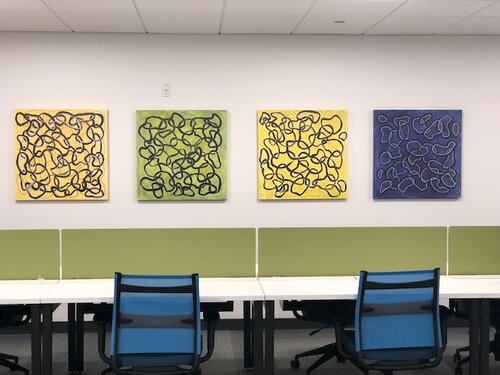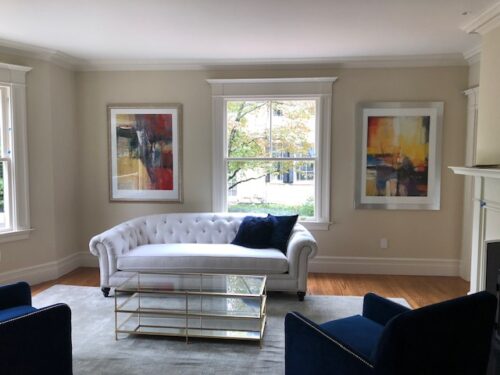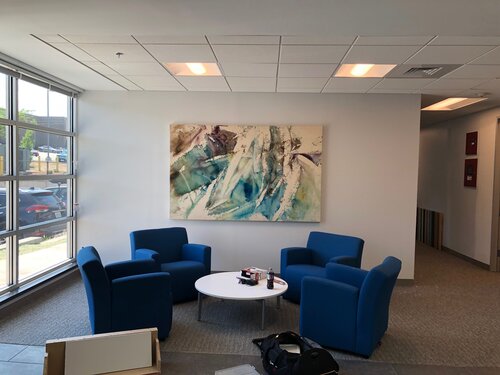by Carolyn Edlund
A candid interview with Joyce Creiger, long time owner of Boston Art Rentals about this niche market, how it works, and the state of the business.

Art rented for a corporate space
AS: How has Boston Art Rentals worked with artists over the years?
JC: When we first started our business, I worked with artists and gave them a percentage of the rental fee, that ranged from 10-20 percent. It wasn’t very profitable for either our company or for the artists. It did give the artists some exposure, however I felt it was more of a waste for both of us.
Eventually I acquired approximately 2,000 works of art, including my personal artwork. This was more profitable. However, I spend $750 a month for storage so I need to have a large number of clients to make it worthwhile.
Generally, we charge $25/ month with a three-month minimum for smaller works, $50 for works over 40″ in either direction, and $75 to $100 for larger works of art. All of our rentals require at least a three-month minimum.

Rented artwork used to stage a room
AS: Who are your typical art rental customers?
JC: Early on, our biggest customers were law and accounting firms. Then we added financial institutions such as hedge funds and money managers. Now most of our clients are realtors who are staging property for sale. We still have a small clientele of law firms, accounting firms, biotech and financial institutions.
AS: Can you give an example of artists getting involved with art rentals?
JC: In our area there is a museum that rents artists’ work as well as art from their own collection. I don’t know what or if they pay the artists, but often clients will purchase the works because they are sponsored by the museum which gives them more credibility.
I’m not sure how profitable this is for the artists. The museum gives the client firm several memberships and classes for their employees. The firm then makes a donation depending on the number of pieces they rent. At one time the minimum was $5,000 for five works of art. I am not sure if that is still the case.

Artwork rented to a commercial client for a waiting room space
AS: What do you see for the future of art rentals?
JC: The internet has destroyed most of the lower-level original art market. When companies can go on the internet to large commercial websites and purchase art for $100-$200 to cover their walls, it’s hard to sell them on more expensive artworks. When we started our business 50 years ago, it wasn’t unusual to sell a law firm a piece of art for $20-$25,000. Today it is difficult to convince them to spend $1,000. For this reason, the art rental business becomes more attractive to them as there is no capital outlay usually requiring a board of directors to make that decision.
I don’t have a crystal ball, so it’s difficult to predict how the art rental business will play out in the future. A lot depends on the interest rates, what capital expenditures companies are looking to make, and if more employees return to the workplace.
Since Covid, so many employees have been working from home. They don’t really want to change the arrangement, as it basically saves them money they would spend on gas, tolls, parking or commuting. They don’t have as many expenses for childcare or dog walkers or fancy clothes. Unless that changes (which is unlikely) companies are downsizing their physical locations. This reduces the need for spending money on decor, plants or artwork.


With the growing influence of the internet and the shift to remote work, art rentals face new hurdles, particularly in maintaining their relevance among cost-conscious businesses. On a personal note, it’s fascinating to see how businesses like Boston Art Rentals have had to adapt, demonstrating the resilience of art in the face of changing economic and social landscapes.